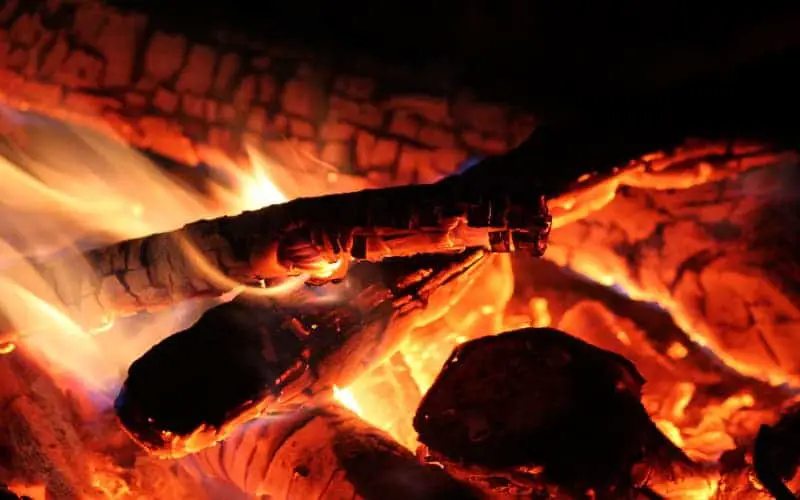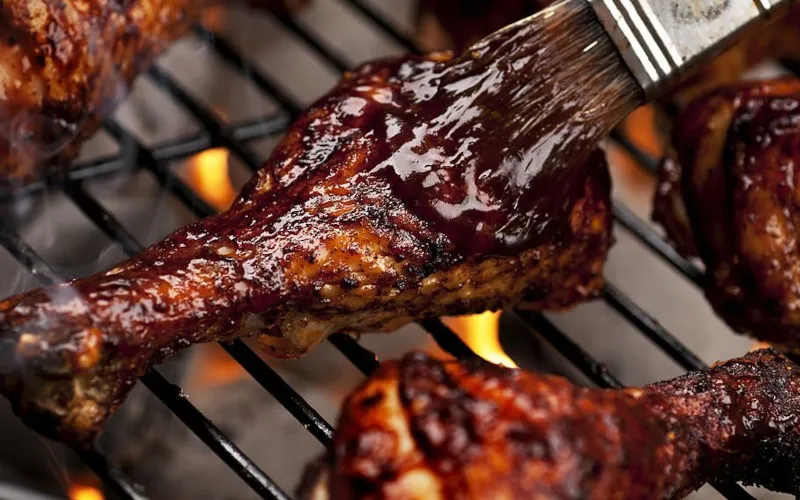Canadian bacon and ham are both pork products, but there are some distinct differences between the two. Ham is made from the hind leg of a pig, while Canadian bacon is made from the loin or back of the pig. Both Canadian bacon and ham are usually smoked and cured.
So what is the difference between pork bacon and Canadian bacon? And which one is better?
What is Canadian Bacon?
Canadian bacon is a type of bacon that is smoked and cured, but not often cooked like regular ham or American-style bacon. Canadian bacon, also known as back bacon, comes from the fatty cut of meat on an animal’s back at the loin section.
What makes this piece popular is that it’s fatter than ham, and not quite as strong as pork belly bacon.
So, it’s a good middle-ground option between traditional ham and other varieties of bacon.
Outside of North America, in countries such as Australia, you might hear Canadian bacon referred to as peameal bacon or back bacon – two similar types of smoked meat that are made from pork loin back cuts. The primary difference between these two varieties is that peameal bacon is rolled in ground yellow peas before being cured and smoked, while back bacon isn’t rolled at all.
In Canada, though, they’re both called Canadian bacon (or sometimes just bacon).
What is Canadian Bacon Good For?
Generally, Canadian bacon is a great source of protein and fat, but not so much in terms of carbohydrates or vitamins and minerals. Unlike ham, Canadian bacon is not generally eaten on its own and is more commonly used as an ingredient in recipes like omelets, burgers, sandwiches, and frittatas.
In Canada, for example, a dish called eggs Benedict traditionally consists of two English muffins topped with Canadian bacon slices and poached eggs in a creamy hollandaise sauce.
What is Ham?
The term ham covers a range of cured meats, but in America, it’s most commonly used to refer to pork that has been cured and/or smoked, often eaten uncooked (think deli sandwiches). An entire leg of pork is referred to as a ham—though it typically refers to a cut called a butt roast or shank half.
While ham can be made from any type of pig, most hams in America are cured with salt-and-sugar brine and smoked over wood chips. The process is similar to that used for making bacon, but hams are typically cured for longer periods and cooked at lower temperatures (less than 160 degrees Fahrenheit).
This process helps ensure that they don’t dry out when cooked—an important consideration given that they’re often eaten uncooked.
Usually, the ham is less fatty with more carbs than bacon and has a milder flavor. It can be eaten on its own or used in a variety of recipes, including casseroles and soups.
What is Ham Good For?
While we’re pretty sure that most of you are well aware of what ham is good for, let’s quickly re-cap for anyone who may have missed out on a few meals: ham is delicious and goes great with eggs in an omelet, sandwiches, or just by itself.
It also can be used to make a variety of different dishes from appetizers and salads to soups and stews. The possibilities really are endless when it comes to incorporating ham into your meal plan. So, if you haven’t tried adding it to your diet yet – now is as good a time as any!
What is the Difference Between Canadian Bacon and Ham?
As with differences between other meats, there are subtle distinctions between Canadian bacon and ham. While they are both pork products, each is cut from a different part of a pig’s hind leg and cured in different ways.
Let’s get to details about these two popular types of meat.
1. Cut
The cut of meat from which Canadian bacon is made comes from a pig’s loin, while ham comes from its hind leg.
2. Curing Process
There are two main types of curing, wet and dry. In wet-curing, pork is soaked in brine, which consists of salt and other seasonings such as sugar or honey, for several days to several weeks before being smoked.
Dry-cured meats are rubbed with salt and left to air-dry for at least a week before being cold-smoked over smoldering wood chips or sawdust for one to three days. Ham is typically dry-cured, while Canadian bacon is usually wet-cured in brine.
3. Nutritional Value
Given that the loin section experiences less exercise than the hind leg section, it is quite obvious that the ham contains less fat than Canadian bacon. The latter also has more marbling though it’s less in calories and cholesterol and is also richer in protein. Ham is rich in carbs, salt, vitamin C, and calcium but fails slightly in protein.
4. Taste and Texture
The flavor of both types of meat is determined by several factors including how they are cured and smoked and whether they are cooked or eaten raw (as in prosciutto). Generally, Canadian bacon is soft, lean, sweet, and less salty while ham is tender, sweet, and saltier.
5. How and Where to Eat
Canadian bacon is mainly considered a breakfast or brunch food and it’s eaten as part of an omelet, with eggs, or in sandwiches. Ham can be served at any meal but is most commonly used for lunch or dinner, either cold (as in a sandwich) or hot (as in a casserole).
While you should cook or warm Canadian bacon before eating, you can choose to eat ham raw or cooked. And because of ham’s salty taste, it goes well with cheese, pickles, and jams as well as a range of savory sauces such as mustard or chutney.
6. Shape
Canadian bacon is found in thick or thin round slices. On the other hand, ham comes spiral-sliced (like a big corkscrew) and can be sliced into cubes, regular slices, very thin slices, or left to be eaten whole as part of prosciutto.
Canadian Bacon vs Ham: Which is Better?
Now that we’ve seen the differences, one may want to know the better option between Canadian bacon and ham. There is no definite answer to which is better because it all depends on your personal preference and taste buds.
Both are great options but if you’re looking for something more savory than sweet then go with Canadian bacon. If you like a little sweetness then go with ham. They both have their pros and cons but when it comes down to it, they’re both delicious!
Top 10 Types Of Bacon
Not all bacon is created equal. There are, of course, your standard varieties: peppered, applewood-smoked, and so on. But there are a whole lot more out there. Do you want to try turkey bacon? (It’s not really bacon.) Or how about piggyback bacon?
It’s made from smoked pork chops that have been sliced into slices and then further cooked until crisp to make them resemble … you guessed it … crispy little strips of bacon! Let’s look into the top 10 types of bacon around.
1. Connoisseur’s Bacon
Some people like their bacon simply cured with salt and smoke, but if you ask connoisseurs they’ll tell you that a fine piece of cured meat requires many additional ingredients to reach its full potential. From maple syrup to coffee grounds to chilies, these recipes will add a variety of flavors while keeping true to classic bacon flavor at its core.
2. Collar bacon
Collar bacon is mainly a cut from the shoulder of a pig, but it can be made from other cuts as well. It is named for its location on the pig, and it’s cut into an oval shape with bone in to help preserve its flavor and texture during cooking.
The meat has good marbling which makes it ideal for smoking or grilling, but it can also be braised or roasted if you prefer those methods of cooking over smoking or grilling.
3. Streaky Bacon
Streaky bacon is known by several names: long cut, Australian or continental bacon are all terms that can be used to describe it. This type of bacon is made from pork belly and is quite fatty with a lean: fat ratio of 1:3.
4. Lardons
A lardon is a strip of bacon that has been diced into small pieces and then cooked in fat or oil until crispy. They are most often used as a garnish for other dishes, but they can also be eaten on their own as a snack or appetizer.
Lardons are typically made from pork belly, but you can also find them made from other cuts of meat including pork shoulder and beef chuck roast.
5. Jowl / Guanciale
Jowl bacon is a cut of pork that comes from between a pig’s head and its throat (cheek region), and it has a similar texture to face bacon with an exceptional flavor profile. It does not have any skin or fat attached to it so you will want to season it well before cooking, but when prepared correctly jowl bacon can be quite delicious.
6. Speck
Speck is a type of bacon that originates from Italy and is obtained from a pig’s leg rather than the belly. It’s more muscular and has a rich, smoky flavor and is usually served as an appetizer, but can also be used in main courses such as casseroles or pasta dishes if you so desire.
7. Szalonna / Hungarian Bacon
Szalonna is also known as Hungarian bacon and is made from pork belly with some skin left on to help protect it from drying out during cooking. It is then smoked for several hours until crispy but still tender, making it perfect for sandwiches or frying in a pan like other types of bacon.
8. Uncured Bacon
Uncured bacon is known as green bacon in some circles and is made from pork belly that has not gone through a process of curing before smoking it. It is often sold as a whole side, meaning you have to cut it up yourself to make slices for cooking or whatever your desire may be for using it.
9. Smoked and Flavored Bacon
There is plenty of flavored, smoked bacon out there to choose from including applewood, hickory, and even bacon-flavored salt to name a few. These types of bacon will all taste good but they are not made from pork belly meat like regular bacon is which means they will likely not taste exactly like what you’re used to as far as flavor goes.
That’s fine though because when it comes to enjoying different types of bacon, variety is definitely a plus!
10. Non-Pork Bacon
Some people who don’t eat pork for religious reasons or otherwise prefer not to can still enjoy a good slab of bacon thanks to types such as turkey bacon, beef bacon, duck bacon, dulse bacon, salmon bacon, and chicken bacon being made available on store shelves these days. You should be able to find a type that is just right for you!
Frequently Asked Questions
How To Eat Canadian Bacon?
There are many ways to enjoy Canadian bacon. It can be eaten alone as a snack, or added to other dishes for extra flavor. It is also a popular breakfast food, often served with eggs and toast. Canadian bacon is relatively lean and has a milder flavor than other types of bacon, making it a good choice for those who do not like the smoky taste of regular bacon.
When purchasing Canadian bacon, look for slices that are evenly trimmed and free of fat. It is also important to make sure that the bacon is fully cooked before eating, as raw bacon can contain harmful bacteria.
Canadian bacon can be cooked in a variety of ways, including frying, grilling, and baking. However, it is important not to overcook bacon, as this can make it tough and chewy.
How To Eat Ham?
One way to eat ham is to slice it thinly and serve it as a main dish. Another way to enjoy ham is to cube it and add it to recipes such as stews, soups, or casseroles. Ham can also be used as an ingredient in dishes such as omelets, quiches, and pasta dishes.
Is Canadian Bacon Healthy?
The fatty parts of Canadian bacon contain plenty of nutrients such as omega-3 fatty acids, vitamin B-12, zinc, and selenium. However, processed meats are known to be bad for your health because they’re often made with ingredients that increase your risk of developing certain diseases such as cancer.
Overall, in moderation, you should be fine eating Canadian bacon just like any other meat.
Is Ham Healthy?
Ham is very high in calcium and contains many nutrients that are good for your health such as iron, selenium, zinc, and vitamins B-6 and B-12. It’s a good option to add to your diet if you’re looking to get more carbs and boost your overall nutrient intake.
Is Smoked Canadian Bacon Safe To Eat Raw?
As with any type of meat, there is always a risk of food poisoning when consuming Canadian bacon raw. While the curing process does help to reduce this risk, it is still important to exercise caution. If you are unsure about the quality of the meat or if you have any concerns, it is always best to cook the bacon before eating.
Is Smoked Ham Safe To Eat Raw?
The simple answer is no, smoked ham is not safe to eat raw. Ham that has been smoked has been cured and preserved through the process of smoking, which does not kill harmful bacteria. Eating raw ham can put you at risk for food poisoning or other illnesses.
If you are planning to eat ham, it is important to cook it properly to ensure that it is safe. Ham should be cooked to an internal temperature of 140 degrees Fahrenheit. Use a meat thermometer to check the temperature of the ham before eating it. When in doubt, err on the side of caution and cook the ham longer rather than shorter.
Does Uncured Canadian Bacon Need To Be Cooked?
Uncured Canadian bacon does not need to be cooked, but it can be if you prefer. It is already smoked and cured, so it is safe to eat without cooking. However, some people prefer to cook it before eating to ensure that it is fully cooked through.
Canadian bacon can be cooked in a variety of ways, such as pan-frying, oven-roasting, or grilling. It is up to you how you want to cook it. If you do choose to cook it, make sure that it reaches an internal temperature of at least 145 degrees Fahrenheit to ensure safety.
Canadian bacon is a delicious and versatile food that can be enjoyed in many different ways. Give it a try and see for yourself!
Is Canadian Bacon Healthy For Diabetics?
As with any food, it is important to check with your doctor or nutritionist to see if Canadian bacon is a good choice for you. While it is lower in fat and calories than other types of pork, it is still a high-fat food. Canadian bacon also contains sodium and should be consumed in moderation by those with diabetes.
How Long Is Cooked Bacon Good For?
Cooked bacon is good for up to 5 days in the refrigerator. If you want it to last longer, you can freeze it for up to 6 months.
Conclusion
Canadian bacon is not ham. It’s made from pork loin while ham is made from pork leg. Canadian bacon and ham are similar in that they are both cured meats, but you can tell them apart by their differences in appearance, taste, and texture.
There are some similarities between Canadian bacon and ham. If you want to enjoy either of these delicious deli meats, be sure to specify what kind of meat you want. You don’t want to end up with a piece of ham when all you wanted was Canadian bacon!





